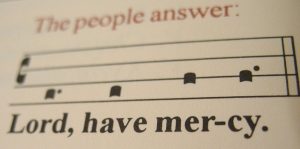Lectionary Reflection for the Fourth Sunday of Easter, Year A
May 11, 2014
The thief comes only to steal and kill and destroy. I came that they may have life, and have it abundantly. John 10:1-10
(This week begins a three-part Easter season stewardship reflection series that examines God’s promises revealed in the gospel portion of the Lectionary readings for the Fourth, Fifth, and Sixth Sundays of Easter. Simply stated, the first is Jesus’ promise of abundant life. The second promises that we will see God revealed in Jesus and that our bold prayers will be answered. The final promise is that God loves us and desires relationship. These three promises help to anchor and inform what it means to be a steward of all of life, of all the goodness and grace of God.) While each lesson is multi-faceted and rich enough to be approached from myriad ways, these passages give preachers an opportunity to speak of stewardship in broad terms.)
Yes, it’s Good Shepherd Sunday, but I ask you to consider pulling back from that familiar theme to look instead at Jesus’ promise of life abundant and how we, in turn, are called to be stewards of that promise. If you have time this week, read John’s gospel in its entirety so that you can better see the pattern the fourth evangelist employs: Jesus gives/performs a sign, those who see the event begin to talk about what they have seen, and Jesus explains/interprets his sign. This rhythm beats throughout John’s gospel, but it’s easy to lose awareness of this pattern in the short snippets that the Revised Common Lectionary offers each week. It’s also easy to lose focus on the fourth evangelist’s message that God loves the world, as well as the promises that articulate this message.
This week, we find Jesus interpreting the healing of the blind man in chapter nine. He speaks of being “the gate” or “door” by which his people enter into a new way of living and being–of life abundant. This promise is for all people, particularly those on the margins and who otherwise find themselves “outside” of the religious and societal structures  and norms of the day. The promise is equally applicable to our time. We certainly have our own abundance of God’s beloved people who desperately need the safety and security of life in Christ and faithful community.
and norms of the day. The promise is equally applicable to our time. We certainly have our own abundance of God’s beloved people who desperately need the safety and security of life in Christ and faithful community.
We begin our stewardship of the promise by clearly and frequently relaying the message — that Jesus desires all people to have abundant life in him. It seems like a no brainer, right? Don’t we do this every week? Perhaps; but communications theory calls for greater frequency and wide saturation of a message. We need to speak this promise plainly and root it in image and words that we can cast as broadly as a biblical sower.
This promise is what God intends for all God’s people. As the visual expression of Christ’s body today, the church (yep, that’s us) is responsible for bearing this promise to the world. We point the way to the door that is Jesus and work to bring others into that new and abundant reality of life in Christ.
To be stewards of this promise requires that we invest in our role as Christ’s body. We take seriously that we are part of a larger whole and a mind-blowing reality of how life can be lived in opposition to the lies and destruction so readily offered up in our culture. It requires that we speak on behalf of those who cannot speak, that we love God and  neighbor, and that we give of ourselves–time, talent, and treasure–with glad and generous hearts. An example of how the early Christian community lived this out can be found in the first reading this week (Acts 2:42-47). Notice that the more these early Christians gave and shared, the more God blessed the body with increase.
neighbor, and that we give of ourselves–time, talent, and treasure–with glad and generous hearts. An example of how the early Christian community lived this out can be found in the first reading this week (Acts 2:42-47). Notice that the more these early Christians gave and shared, the more God blessed the body with increase.
How will/does stewarding this promise look in your context? Only you as leader and the beloved community you serve can prayerfully and faithfully discern an answer. Maybe one place to begin is with questions. What missions and ministry are you already engaged in? What are you contemplating? Who is not gathered at the table with you? Who is outside your doors, excluded and in need? How do you see and experience this promise in your own community as individuals and corporately?
Jesus’ words and purpose are clear: he came that all may have life, and have it abundantly. This is good news and faithful promise. Go. Share. Love. Do. In the process you will steward this message of life and hope to a hungry and hurting world. Blessings on the journey!
In Worship
Are we half full or filled to overflowing? Sometimes our faith communities forget their abundance and God’s promise of the abundant life. We need frequent reminders of how this promise is being lived out in our midst. Most of us have heard parishioners lament about the “good ‘ol days” when Sunday school rooms were filled to overflowing, when the pews were packed, and the budgets were bounteous. It’s easy to paint a nostalgic picture for the way things were in mainline Christianity.
Instead, invite your parishioners to paint a new picture of abundance today. Think about all the wonderful programs, people, and practices that make your expression of Christ’s Body what it is right now. Find a space to place a large blank canvas, primed plywood board, or large heavy paper (butcher or heavy newsprint) on a wall or flat surface. Assemble extra photocopies or copies of photos of your congregation in action. Provide colorful markers or paints and other materials (perhaps a multimedia collage?), and invite worshipers to paint a new picture of how God is giving life abundant in your context.
If you’re a tech-savvy bunch, consider inviting people to take their smart phones and tablets around the building to capture images. You can use small white boards to allow people to use words, as well. Assemble a Facebook album or Pinterest board to share the life abundant in your faith community.
With Youth
If you are able, get a copy of Material World: A Global Family Portrait by Peter Menzel, Charles C. Mann, and Paul Kennedy (Sierra Club Books, 1995). These photographers took photos of 30 statistically average families around the globe with all of their possessions. It’s a fascinating look at stuff and our ideas of the good life. You can also click here to access 12 of the photos in an NPR article.
Ponder whether our possessions constitute the kind of good life Jesus is talking about in today’s gospel passage. What is life abundant? Can you experience life abundant no matter what you have or don’t have? Is there a minimum or maximum? How did the early Christians in today’s first reading from Acts experience this abundant life? If we’re not “content” or “satisfied” with our present life, what can we learn from Jesus about how to have this kind of life?
With Children
In John’s gospel today, we learn that the sheep know the shepherd’s voice and will follow only their shepherd. We know the voices we can trust, too. Have one child volunteer to be blindfolded. Have that child’s mother or father and two other mothers or fathers volunteer to be part of your “shepherd’s voice” experiment (Note: you may need to arrange for volunteers first) . Blindfold the child. Ask the three volunteer mothers or fathers to each call the child’s name in turn. Make sure the child’s parent is the last voice. The child should be able to pick out his or her parent’s voice clearly.
Point out that just like the child knew his or her parent’s voice, so Jesus’ followers know his voice and follow him. But wait! How can we hear Jesus’ voice today? Let the children guess and give answers. Lead them to understand that we hear Jesus’ voice in many ways–in scripture, in prayer, and in the voices of their parents teaching them the Creed, Ten Commandments, and the Lord’s Prayer, and other ways. Remind the children to listen for Jesus always and follow his way. Finish with a simple prayer for ears to hear, eyes to see, and hearts to love.
Photos: fady habib, Martin Fisch, and Matt, Creative Commons




Leave a Reply